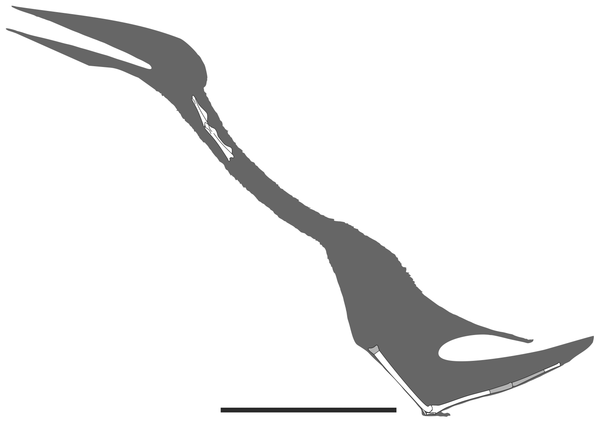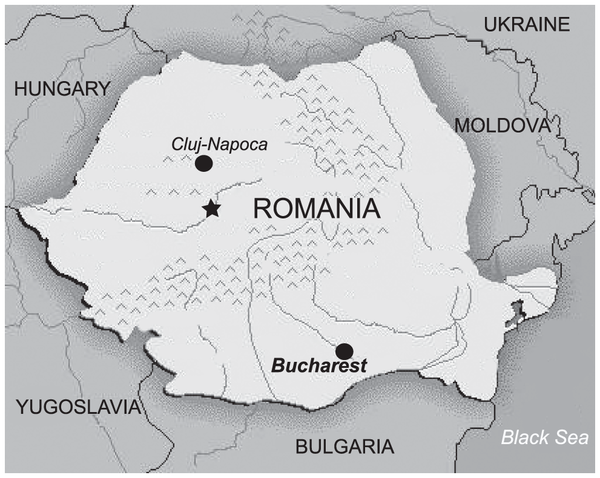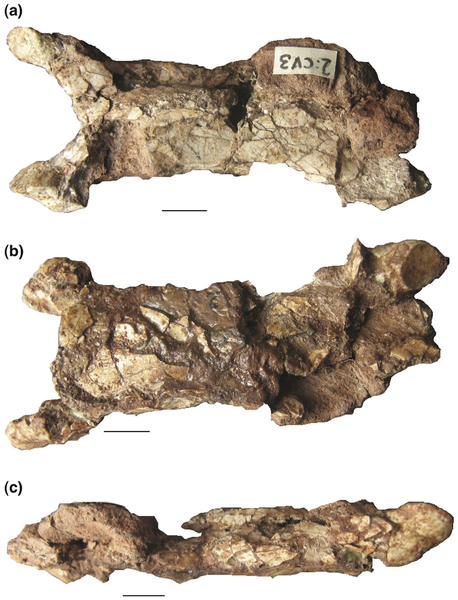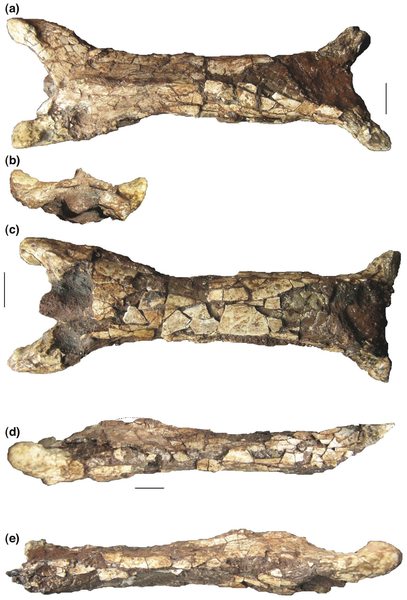Post by creature386 on Aug 17, 2013 21:57:47 GMT 5
Eurazhdarcho langendorfensis

Author: Mark Witton
Preserved bones are shown here.
Scalebar: 0,5 m[1]
Temporal range: Maastrichtian[2]
Location: Sebe? Formation, Lancr?m (Langendorf), Romania[2]

The star shows the location.[3]
Scientific classification:
Pterosauria
Pterodactyloidea
Azhdarchoidea
Azhdarchidae
Eurazhdarcho
E. langendorfensis[4]
Description:
Eurazhdarcho langendorfensis was a medium sized pterosaur (estimated wingspan of ~3 m[1]), known from a partial skeleton (EME VP 312; holotype).[4] Not many bones are known, but when there are bones, they are well preserved. Especially the cervical vertebrae are well preserved, they are preserved in three dimensions. The most complete cervical vertebra is the cervical four (C4), which is quite elegant and gracile.[5] The elongation ratio ranges from 3,0-6,1.[6] The cervical tree is 3/4 times as long as the cervical four (the cervical three has an estimated total length of 9 cm[7]), that is a diagnostic feature.[4]


Cervical vertebrae three (the ones in the upper picture) and four (the ones in the other picture).[7]
The elongated prezygapophyseal pedicles on the cervical vertebrae are another.[4] The latter feature is used to differ it from another azhdarchid pterosaur species from France, which has short and robust prezygapophyseal pedicles.[8]
Phylogenetic position:
Eurazhdarcho langendorfensis belongs to the family Azhdarchidae. It was referred to that family based on the tube-like cervical centra, elongated mid-cervicals and the reduced neural spine.[4]
Members of the family Azhdarchidae are known from Europe, North Africa, North America and Asia.[9]

Global distribution of azhdarchids.[1]
The discovery of Eurazhdarcho langendorfensis supports the theory of azhdarchids not just living in coastal habitats, but also in environments like woodlands, riverplains and scrublands, as it (and many other azhdarchids) was found together with dinosaurs and other not coastal animals.[9]
Literature:
Romania Vremir M, Kellner AWA, Naish D, Dyke GJ (2013) A New Azhdarchid Pterosaur from the Late Cretaceous of the Transylvanian Basin, Romania: Implications for Azhdarchid Diversity and Distribution. In: PLoS ONE 8(1): e54268. p. 1-15 doi:10.1371/journal.pone.0054268
Footnotes:
[1] Vremir et al. 2013 p. 12
[2] Vremir et al. 2013 p. 1
[3] Vremir et al. 2013 p. 2
[4] Vremir et al. 2013 p. 4
[5] Vremir et al. 2013 p. 7
[6] Vremir et al. 2013 p. 11
[7] Vremir et al. 2013 p. 8
[8] Vremir et al. 2013 p. 5
[9] Vremir et al. 2013 p. 13
Author: Mark Witton
Preserved bones are shown here.
Scalebar: 0,5 m[1]
Temporal range: Maastrichtian[2]
Location: Sebe? Formation, Lancr?m (Langendorf), Romania[2]
The star shows the location.[3]
Scientific classification:
Pterosauria
Pterodactyloidea
Azhdarchoidea
Azhdarchidae
Eurazhdarcho
E. langendorfensis[4]
Description:
Eurazhdarcho langendorfensis was a medium sized pterosaur (estimated wingspan of ~3 m[1]), known from a partial skeleton (EME VP 312; holotype).[4] Not many bones are known, but when there are bones, they are well preserved. Especially the cervical vertebrae are well preserved, they are preserved in three dimensions. The most complete cervical vertebra is the cervical four (C4), which is quite elegant and gracile.[5] The elongation ratio ranges from 3,0-6,1.[6] The cervical tree is 3/4 times as long as the cervical four (the cervical three has an estimated total length of 9 cm[7]), that is a diagnostic feature.[4]
Cervical vertebrae three (the ones in the upper picture) and four (the ones in the other picture).[7]
The elongated prezygapophyseal pedicles on the cervical vertebrae are another.[4] The latter feature is used to differ it from another azhdarchid pterosaur species from France, which has short and robust prezygapophyseal pedicles.[8]
Phylogenetic position:
Eurazhdarcho langendorfensis belongs to the family Azhdarchidae. It was referred to that family based on the tube-like cervical centra, elongated mid-cervicals and the reduced neural spine.[4]
Members of the family Azhdarchidae are known from Europe, North Africa, North America and Asia.[9]
Global distribution of azhdarchids.[1]
The discovery of Eurazhdarcho langendorfensis supports the theory of azhdarchids not just living in coastal habitats, but also in environments like woodlands, riverplains and scrublands, as it (and many other azhdarchids) was found together with dinosaurs and other not coastal animals.[9]
Literature:
Romania Vremir M, Kellner AWA, Naish D, Dyke GJ (2013) A New Azhdarchid Pterosaur from the Late Cretaceous of the Transylvanian Basin, Romania: Implications for Azhdarchid Diversity and Distribution. In: PLoS ONE 8(1): e54268. p. 1-15 doi:10.1371/journal.pone.0054268
Footnotes:
[1] Vremir et al. 2013 p. 12
[2] Vremir et al. 2013 p. 1
[3] Vremir et al. 2013 p. 2
[4] Vremir et al. 2013 p. 4
[5] Vremir et al. 2013 p. 7
[6] Vremir et al. 2013 p. 11
[7] Vremir et al. 2013 p. 8
[8] Vremir et al. 2013 p. 5
[9] Vremir et al. 2013 p. 13


